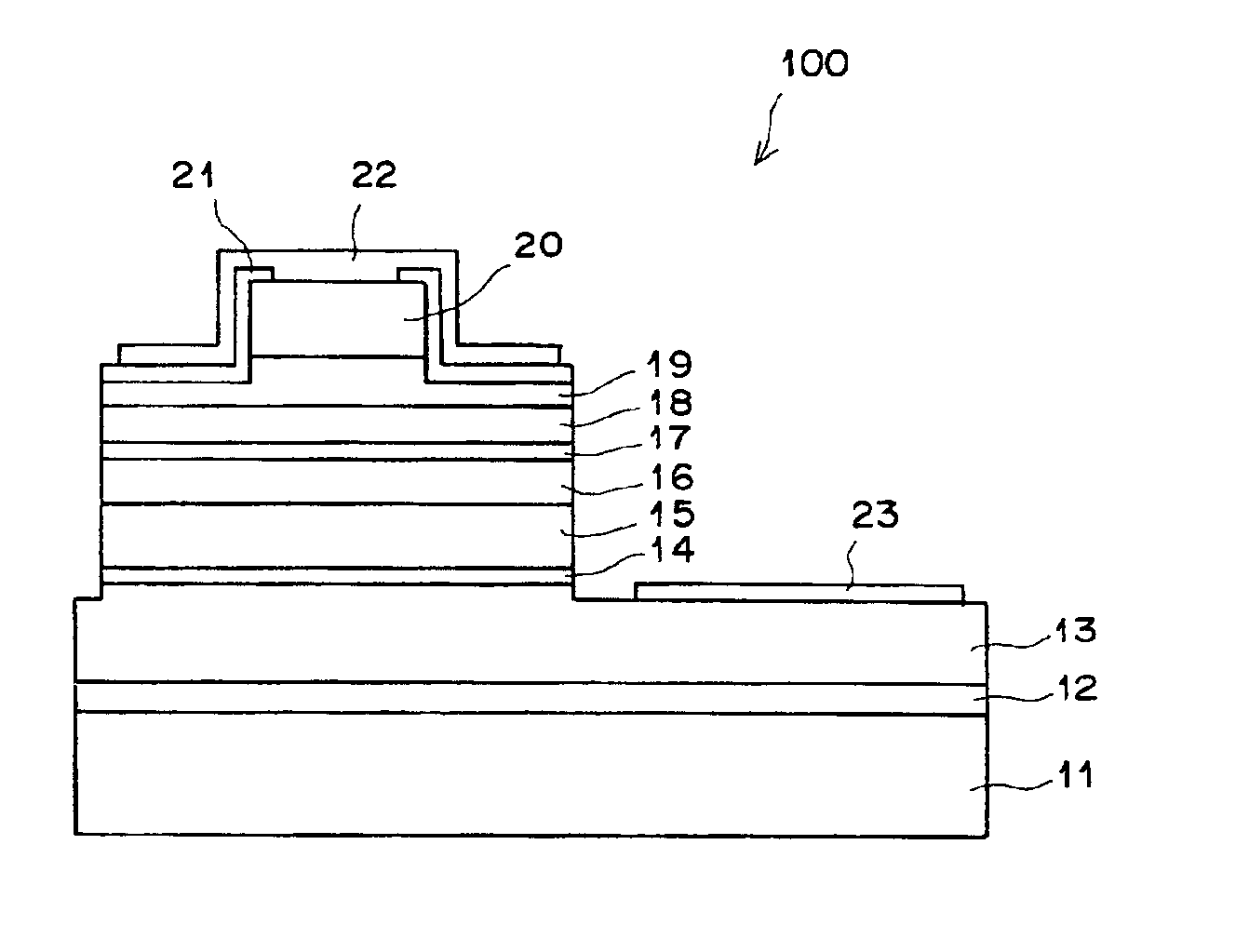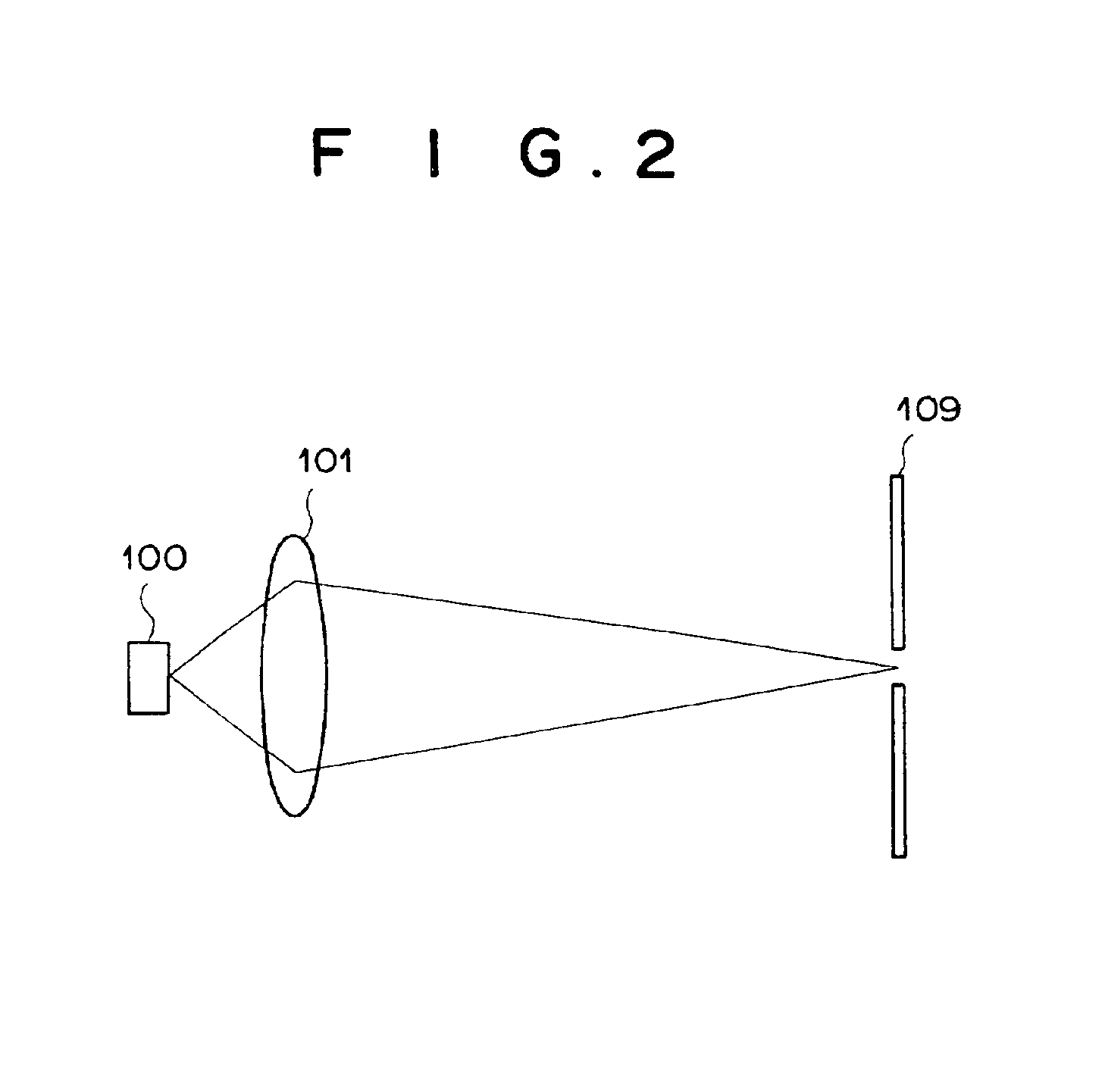Light-emitting diode
a diode and light-emitting technology, applied in the field of light-emitting diodes, can solve the problems of increasing printing costs, not being widely used, and not being practical with the diode for green and blue, and achieve the effect of increasing the quantity of light and high outpu
- Summary
- Abstract
- Description
- Claims
- Application Information
AI Technical Summary
Benefits of technology
Problems solved by technology
Method used
Image
Examples
first embodiment
[0026]An InGaN blue LED according to the present invention will hereinafter be described with reference to FIG. 1, along with the fabrication process thereof.
[0027]As shown in FIG. 1, an n-GaN low-temperature buffer layer 12, an n-GaN buffer layer 13 (doped with Si and of a thickness of 5 μm), an n-In0.05Ga0.95N buffer layer 14 (doped with Si and of a thickness of 0.1 μm), an n-Al0.15Ga0.85N clad layer 15 (doped with Si and a thickness of 0.4 μm), an n-GaN optical guide layer 16 (doped with Si and of a thickness of 0.12 μm), an undoped active layer 17, a p-GaN optical guide layer 18 (doped with Mg and of a thickness of 0.12 μm), a p-Al0.15Ga0.85N clad layer 19 (doped with Mg and of a thickness of 0.4 μm), and a p-GaN cap layer 20 (doped with Mg and of a thickness of 0.3 μm), are grown epitaxially upon a sapphire C-plane substrate 11 by metalorganic chemical-vapor deposition (MOCVD). Thereafter, a p-type impurity is activated in an ambient atmosphere of nitrogen gas by heat treatment...
second embodiment
[0035]Next, an InGaN blue LED according to the present invention will be described with reference to FIG. 4, along with the fabrication process.
[0036]The LED of the second embodiment is the same in basic layer structure and fabrication method as the first embodiment. Therefore, the same reference numerals will be applied to the same parts as the first embodiment to avoid redundancy.
[0037]In the LED with a stripe width of 4 μm according to the second embodiment, the thicknesses of an n-GaN guide layer 16 and a p-GaN optical guide layer 18 are both set thicker (1.5 μm). In addition, the ridge process is performed so that a portion of the n-GaN guide layer 16 other than the stripe portion is removed. If the entire optical guide layer is thus formed into a stripe shape, spontaneous emission light is effectively guided to the front facet of the LED and therefore the light-collecting efficiency is enhanced.
[0038]Next, an InGaN blue LED according to a third embodiment of the present invent...
third embodiment
[0039]As shown in FIG. 5, in the LED of the third embodiment, the 6H—Si substrate 31 with n-type conductivity is employed as the substrate. For this reason, an n-type electrode 23 is formed on the bottom surface of the 6H—Si substrate 31.
[0040]In the three embodiments described above, the LEDs have light emission wavelengths in a blue region. However, the present invention is also applicable to LEDs having light emission wavelengths in a region of green (492 nm or greater), a region of violet (450 nm or less), or an ultraviolet region of further shorter wavelengths. For ultraviolet, for instance, the present invention is also applicable to an LED which has a GaN or AlGaN active layer, an AlGaN optical guide layer, and an AlGaN clad layer. An AlGaN / GaN superlattice, etc., can be employed as the clad layer.
[0041]Furthermore, in the aforementioned embodiments, the ridge-shaped stripe structure with an insulating film has been described as the device structure. However, the present inve...
PUM
 Login to View More
Login to View More Abstract
Description
Claims
Application Information
 Login to View More
Login to View More - R&D
- Intellectual Property
- Life Sciences
- Materials
- Tech Scout
- Unparalleled Data Quality
- Higher Quality Content
- 60% Fewer Hallucinations
Browse by: Latest US Patents, China's latest patents, Technical Efficacy Thesaurus, Application Domain, Technology Topic, Popular Technical Reports.
© 2025 PatSnap. All rights reserved.Legal|Privacy policy|Modern Slavery Act Transparency Statement|Sitemap|About US| Contact US: help@patsnap.com



